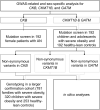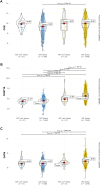Genetic variants in genes involved in creatine biosynthesis in patients with severe obesity or anorexia nervosa
- PMID: 37101650
- PMCID: PMC10123275
- DOI: 10.3389/fgene.2023.1128133
Genetic variants in genes involved in creatine biosynthesis in patients with severe obesity or anorexia nervosa
Abstract
Increased thermogenesis in brown adipose tissue might have an obesity-reducing effect in humans. In transgenic mice, depletion of genes involved in creatine metabolism results in disrupted thermogenic capacity and altered effects of high-fat feeding on body weight. Data analyses of a sex-stratified genome-wide association study (GWAS) for body mass index (BMI) within the genomic regions of genes of this pathway (CKB, CKMT1B, and GATM) revealed one sex-dimorphic BMI-associated SNP in CKB (rs1136165). The effect size was larger in females than in males. A mutation screen of the coding regions of these three candidate genes in a screening group (192 children and adolescents with severe obesity, 192 female patients with anorexia nervosa, and 192 healthy-lean controls) identified five variants in each, CKB and GATM, and nine variants in the coding sequence of CKMT1B. Non-synonymous variants identified in CKB and CKMT1B were genotyped in an independent confirmation study group (781 families with severe obesity (trios), 320 children and adolescents with severe obesity, and 253 healthy-lean controls). In silico tools predicted mainly benign yet protein-destabilizing potentials. A transmission disequilibrium test in trios with severe obesity indicated an obesity-protective effect of the infrequent allele at rs149544188 located in CKMT1B. Subsequent correlation analyses in 1,479 individuals of the Leipzig Obesity BioBank revealed distinct correlations of CKB with the other two genes in omental visceral adipose tissue (VAT) and abdominal subcutaneous adipose tissue (SAT). Furthermore, between-subject comparisons of gene expression levels showed generally higher expressions of all three genes of interest in VAT than in SAT. Future in vitro analyses are needed to assess the functional implications of these findings.
Keywords: BAT; GWAS; TDT; creatine metabolism; in silico.
Copyright © 2023 Rajcsanyi, Hoffmann, Ghosh, Matrisch-Dinkler, Zheng, Peters, Sun, Dong, Noé, Wolfrum, Herpertz-Dahlmann, Seitz, de Zwaan, Herzog, Ehrlich, Zipfel, Giel, Egberts, Burghardt, Föcker, Tsai, Müller, Blüher, Hebebrand, Hirtz and Hinney.
Conflict of interest statement
The authors declare that the research was conducted in the absence of any commercial or financial relationships that could be construed as a potential conflict of interest.
Figures





Similar articles
-
Visceral adiposity and inflammatory bowel disease.Int J Colorectal Dis. 2021 Nov;36(11):2305-2319. doi: 10.1007/s00384-021-03968-w. Epub 2021 Jun 9. Int J Colorectal Dis. 2021. PMID: 34104989 Review.
-
PTBP2 - a gene with relevance for both Anorexia nervosa and body weight regulation.Transl Psychiatry. 2022 Jun 9;12(1):241. doi: 10.1038/s41398-022-02018-5. Transl Psychiatry. 2022. PMID: 35680849 Free PMC article.
-
Lipocalin 2 - mutation screen and serum levels in patients with anorexia nervosa or obesity and in lean individuals.Front Endocrinol (Lausanne). 2023 Mar 21;14:1137308. doi: 10.3389/fendo.2023.1137308. eCollection 2023. Front Endocrinol (Lausanne). 2023. PMID: 37025415 Free PMC article.
-
Fine Mapping of a GWAS-Derived Obesity Candidate Region on Chromosome 16p11.2.PLoS One. 2015 May 8;10(5):e0125660. doi: 10.1371/journal.pone.0125660. eCollection 2015. PLoS One. 2015. PMID: 25955518 Free PMC article.
-
Under the Surface of Subcutaneous Adipose Tissue Biology.Acta Dermatovenerol Croat. 2016 Dec;24(4):250-260. Acta Dermatovenerol Croat. 2016. PMID: 28128075 Review.
Cited by
-
Identification of key metabolism-related genes and pathways in spontaneous preterm birth: combining bioinformatic analysis and machine learning.Front Endocrinol (Lausanne). 2024 Aug 20;15:1440436. doi: 10.3389/fendo.2024.1440436. eCollection 2024. Front Endocrinol (Lausanne). 2024. PMID: 39229380 Free PMC article.
-
Creatine Acts as a Mediator of the Causal Effect of Obesity on Puberty Onset in Girls: Evidence from Mediation Mendelian Randomization Study.Metabolites. 2024 Feb 25;14(3):137. doi: 10.3390/metabo14030137. Metabolites. 2024. PMID: 38535297 Free PMC article.
-
Identifying KLF14 as a potential regulatory factor in liver regeneration trough transcriptomic and metabolomic.Sci Rep. 2025 Mar 3;15(1):7462. doi: 10.1038/s41598-025-87614-3. Sci Rep. 2025. PMID: 40032908 Free PMC article.
-
Functional roles of pantothenic acid, riboflavin, thiamine, and choline in adipocyte browning in chemically induced human brown adipocytes.Sci Rep. 2024 Aug 6;14(1):18252. doi: 10.1038/s41598-024-69364-w. Sci Rep. 2024. PMID: 39107469 Free PMC article.
References
Grants and funding
LinkOut - more resources
Full Text Sources
Research Materials
Miscellaneous

